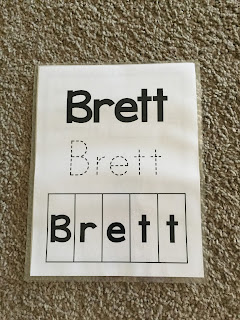Welcome to the first post in the 6 week Back To School series for Special Education! This week is all about scheduling. Scheduling in the special ed classroom can be seriously tricky. Special Ed classrooms typically need to fit in reading, math, and other standard academics as well as social skills, life skills, physical therapy, occupational therapy, speech therapy, and a million other things. Having a consistent and efficient schedule is the first step in creating a comfortable learning environment. Sitting down to write a schedule for your special ed classroom can seem like a daunting task, but myself and some other fantastic sped bloggers have put together tips and tricks to help you get started!
The following tips are strategies I use to create a color coded, puzzle worthy schedule in my self-contained cross categorical classroom for students with mild to severe cognitive disabilities. I start with a basic class schedule and then make the master student schedules.
The following tips are strategies I use to create a color coded, puzzle worthy schedule in my self-contained cross categorical classroom for students with mild to severe cognitive disabilities. I start with a basic class schedule and then make the master student schedules.
- Academic Essentials- Your schedule is going to have some essential components. Think IEP minutes. You know Student A needs to receive 60 minutes of daily reading instruction. Write that down. Write down all of those essential components for every student. It is going to be a looooooong list, but don't worry.
- Permanent Fixtures- Open up a spreadsheet program like Excel. Make a simple spreadsheet that shows time (I use 15 minute intervals) in the rows and student names in the columns. Block out chunks of time for elements that you don't have control over their time. For me, this is things like lunch, Early Release Wednesdays (new this year.... yay!), and specials. My kids go to specials with their grade level and an aide, so, you'll see blocks of time for specials occurring at different times for each student. If your students all go to specials at the same time, I envy you so hard.
- Moving Must-Haves- These are schedule items that are essential each day, but you have control over their timing. These essentials are going to be different for each class. I teach in a self-contained classroom for young kiddos and the overwhelming majority of my class (10/11) wear diapers and/or having toilet training goals. So, toileting is a big deal for us and has to be carefully scheduled into each day. Other examples of Moving Must-Haves are recess, choice time, Circle Time/Morning Meeting, or data collections time. Add these items to your schedule next.
- Groups- Grouping students can seem like a puzzle within the puzzle of scheduling. There are a few different approaches to grouping students. Some teachers group students by abilities like reading levels. Other teachers group students by like goals. And some group students by meshing personalities. All of these approaches have their merits and some work better than other for particular students. Personally, I like to group students by like goals. My kiddos are young and small groups flow better when we are all working on the same thing. In the event that I have more students with a like goal than I like in a small group, I look to behavior next. Every class has those 2 kids that will kill you if they are in a group together or students who more direct attention in a small group than others. I make the groups on the side of my schedule so that I can easily copy and paste them into time slots.
- Plug It All In- I have a love/hate relationship with this part of schedule writing. It's a giant puzzle and the page starts to fill up which I love, then 10 minutes in, my brain hurts and I need chocolate to keep going. I have a feeling I'm not alone on this one. So, I write down all of the academic components I want to hit each day- math groups, workshop, phonics groups, teacher table, etc. Then I assign a time limit for each item. We do math groups for 30 minutes, but teacher table is only 15 minutes. I try to do them time blocks that are factors of the time interval on my spreadsheet. Trust me, it works out much pretty this way. Start plugging in your groups
- Color-Coding- The fun part, making it pretty. Color coding the schedule serves more purpose than aesthetics. I assign a color to each adult in the room and a color for when all are involved. Next,, fill in the box that each adult is responsible for with their color. This can save you from 2 major mistakes, creating more groups that adults in the room or "double-booking" a therapist or para.
- Adult Schedules- Next I make schedules for all of the adults in my room. The first week of school is mostly about getting scheduling down for my students and adults, so it is nice to have a little cheat sheet until it becomes routine.
- Empty Spaces- You will notice that there are some blank spaces in some areas. I always leave a little wiggle room so that when therapist come to me before school looking for scheduling opportunities, I'm not redoing the schedule each time. Granted as pretty as the schedule looks, I know that it will change. Things happen, but having a solid starting point makes the tweaking later MUCH easier and less stressful for you and everyone involved. Check back next week for tips on setting up your classrooms!
How do you piece together your schedule puzzle? Click on the link below to continue on the hop and get some more scheduling tips from fellow sped bloggers!















